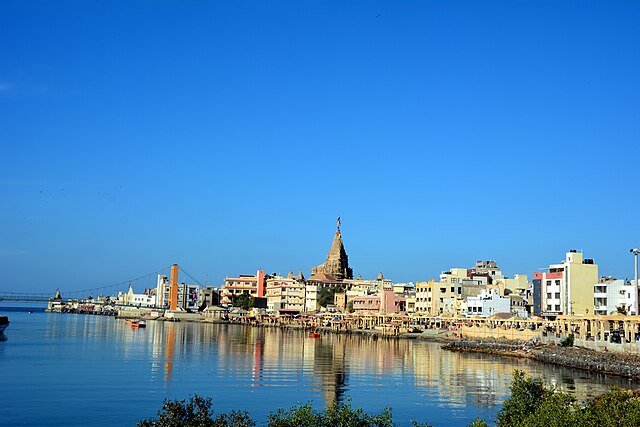Dwarkadhish Temple: Best Complete Guide to the Kingdom of Lord Krishna
- Location: Dwarka
- Timings: Morning: 6:30 AM – 1:00 PM Evening: 5:00 PM – 9:30 PM
- Categories: Religious /Spiritual Sites, Temple, Tourist Places
- Tags: Char Dham temples in India, CharDham, Dwarka tourism guide, Dwarkadhish Temple, DwarkadhishTemple, DwarkaTourism, Gujarat Heritage, Jagat Mandir Dwarka, Krishna temples in Gujarat, LordKrishna
- Location Taxonomy: Devbhumi Dwark, Gujarat, India
India is a land of timeless spiritual heritage, and among its most sacred pilgrimage sites stands the Dwarkadhish Temple in Gujarat. Also known as the Jagat Mandir, this temple is dedicated to Lord Krishna, worshipped here as the “King of Dwarka.” Situated on the western coast of India, overlooking the Arabian Sea, the temple is one of the four Char Dham pilgrimage sites, alongside Badrinath, Rameshwaram, and Puri.
With a history dating back over 2,500 years, the Dwarkadhish Temple is not just a place of worship but also a symbol of devotion, architecture, and mythology. It is believed to have been originally built by Vajranabh, the great‑grandson of Lord Krishna, over Krishna’s residence called Harigriha. Over centuries, the temple has been destroyed and rebuilt multiple times, yet it continues to stand tall as a beacon of faith.
This article explores the history, architecture, legends, cultural significance, nearby attractions, and travel tips for visiting the Dwarkadhish Temple.
Historical Background of Dwarkadhish Temple

- Origins: Believed to have been constructed around 200 BCE by Vajranabh.
- Dynasties: Renovated and expanded by rulers such as the Chavdas, Solankis, and later by the Gaekwads.
- Invasions: The temple faced destruction during invasions by Mahmud Begada in the 15th century but was rebuilt in the 16th century.
- Adi Shankaracharya: The great philosopher visited the temple in the 8th century, and a memorial stands in his honor.
The Dwarkadhish Temple is not just a monument but a living testimony of India’s resilience and devotion.
Architectural Brilliance of Dwarkadhish Temple

The temple is a masterpiece of Hindu architecture, built primarily from limestone and sandstone.
Key Features:
- Five‑Storied Structure: Rising to a height of 78 meters, supported by 72 intricately carved pillars.
- Shikhara (Spire): Crowned with a 52‑yard long flag, changed three times a day.
- Sanctum (Garbha Griha): Houses the black idol of Lord Krishna, adorned with jewels and silk garments.
- Mandapas: Includes the Sabha Mandap (assembly hall) and the sanctum mandap.
- Carvings: Depict scenes from Mahabharata, Ramayana, and Puranas.
The temple’s location at the confluence of the Gomti River and the Arabian Sea adds to its grandeur.
Legends and Mythology

- Krishna’s Kingdom: Dwarka was established by Lord Krishna after leaving Mathura.
- Submerged City: Legends say Dwarka was submerged by the sea six times, and the current city is its seventh incarnation.
- Gomti Ghat: Pilgrims take a holy dip in the Gomti River before entering the temple.
- Char Dham: The Dwarkadhish Temple is one of the four sacred Char Dham sites, believed to grant moksha (salvation).
Location and Accessibility

- City: Dwarka, Gujarat
- Nearest Airport: Jamnagar Airport (137 km)
- Nearest Railway Station: Dwarka Railway Station (2 km)
- By Road: Well‑connected to Ahmedabad, Rajkot, and Jamnagar
Best Time to Visit Dwarkadhish Temple
- October to March: Pleasant weather, ideal for sightseeing.
- Janmashtami Festival: Celebrated with grandeur, attracting thousands of devotees.
- Morning and Evening Aarti: The most spiritual times to experience the temple.
Temple Timings and Rituals
- Morning: 6:30 AM – 1:00 PM
- Evening: 5:00 PM – 9:30 PM
- Aarti Timings:
- Mangla Aarti: 6:30 AM
- Shringar Aarti: 10:30 AM
- Sandhya Aarti: 7:30 PM
- Shayan Aarti: 9:00 PM
Things to See at Dwarkadhish Temple
- Main Idol of Krishna: Black stone idol, richly decorated.
- Sabha Mandap: Pillared hall with intricate carvings.
- Gomti Ghat: Sacred bathing steps leading to the river.
- Flag Changing Ceremony: A unique ritual performed thrice daily.
- Smaller Shrines: Dedicated to Subhadra, Balarama, and other deities.
Nearest Tourist Places to Dwarkadhish Temple
- Rukmini Devi Temple (2 km): Dedicated to Krishna’s consort, Rukmini.
- Nageshwar Jyotirlinga (12 km): One of the 12 Jyotirlingas of Lord Shiva.
- Beyt Dwarka Island (30 km): Believed to be Krishna’s residence, accessible by boat.
- Okha Port (30 km): Scenic coastal town with beaches.
- Somnath Temple (230 km): Another Jyotirlinga and important pilgrimage site.
Travel Tips for Visitors
- Dress modestly and follow temple etiquette.
- Photography is not allowed inside the sanctum.
- Book accommodation in advance during festivals.
- Combine your trip with Somnath and Gir National Park for a complete Gujarat tour.
- Participate in the evening aarti for a divine experience.
❓ FAQs about Dwarkadhish Temple
Q1: Who built the Dwarkadhish Temple?
A: It is believed to have been built by Vajranabh, the great‑grandson of Lord Krishna, around 200 BCE.
Q2: Why is Dwarkadhish Temple famous?
A: It is one of the Char Dham pilgrimage sites and is dedicated to Lord Krishna as the King of Dwarka.
Q3: What is the best time to visit Dwarkadhish Temple?
A: October to March, and during Janmashtami for grand celebrations.
Q4: How old is the Dwarkadhish Temple?
A: The temple is over 2,500 years old, though the current structure dates back to the 16th century.
Q5: Can tourists visit nearby attractions from Dwarka?
A: Yes, nearby sites include Rukmini Devi Temple, Nageshwar Jyotirlinga, and Beyt Dwarka Island.
🌅 Conclusion
The Dwarkadhish Temple is not just a place of worship but a living embodiment of India’s spiritual and cultural heritage. With its deep historical roots, architectural grandeur, and divine aura, it continues to inspire millions of devotees and travelers. Whether you seek spiritual solace, cultural exploration, or architectural wonder, a visit to the Dwarkadhish Temple in Dwarka is an unforgettable journey into the heart of Krishna’s kingdom.

